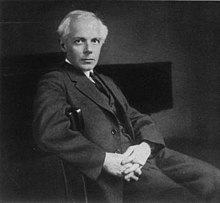Béla Bartók
(1881-1945)
 Bela Bartok lived during the Romantic era and significantly developed the characteristics of Hungarian nationalist compositions. His music was a beautiful blend of widely diverse harmonies and strong rhythms deriving from eastern European folk music. The result is music that displays a definite national spirit, yet also takes its place as a cornerstone of music in the 20th century.
Bela Bartok lived during the Romantic era and significantly developed the characteristics of Hungarian nationalist compositions. His music was a beautiful blend of widely diverse harmonies and strong rhythms deriving from eastern European folk music. The result is music that displays a definite national spirit, yet also takes its place as a cornerstone of music in the 20th century.
In the town of Nagyszentmiklos, once in Hungary but now part of Romania, Bartok was born to a family who would soon only have his mother for support. When Bartok began composing early, he was offered instruction at the Academy of Music in Budapest, however his mother could not part with him. Bartok’s family moved roughly five times in the span of two years, often between countries as the continuously shifting political powers made borders quite fluid. Consequently, the Hungarian sought a stronger means of establishing his nationality. His early music demonstrates a firm grasp of classical forms and techniques, but after Bartok discovered the music of Strauss, his compositional style significantly changed. He also became inspired to develop a specifically Hungarian style. Soon Bartok would discover that most composers attempting to impart a Hungarian sound were not modeling true indigenous sources, but merely imitating the gypsy style popularized by Liszt. The realization inspired Bartok to notate a sung peasant song in 1904, and he became convinced that authentic folksongs contained numerous possibilities for serious composition.
By this time, Kodaly had produced his first study of folk music and the two composers would begin collaborating. They published an ultimately unsuccessful volume of Hungarian folk-based music, but the failure prompted Bartok to more seriously research folk songs in order to better understand the specific characteristics and how to make them palatable for mass audiences. Between his findings in eastern Europe and Kodaly’s discovery of Debussy, the mixture of both influences would create the first Bartok composition that truly blended peasant song and art music together: String Quartet No. 1. By 1912, although Bartok’s compositions were growing in popularity, publishers were less interested in his newer material. Consequently, he published less, focusing even more on developing his folk material, and by the 1920s he had collected thousands of eastern European folk tunes, demonstrating the wealth of folk music and enhancing public musical education. He also performed regular recital tours throughout Europe to promote Hungarian folk music. At one point, Bartok did not compose new material for 18 months, preferring to spend the time touring and teaching. He also spent this time protesting the rising fascism in Europe. After his Frankfurt performance in 1933, he never again played in Germany and forbid his music be broadcast in both Germany and Italy. Bartok even abandoned the Austrian publisher, Universal Edition, in favor of Boosey & Hawkes. He only remained in Budapest until his mother’s death in 1939, at which time he traveled to America.
After Bartok learned of The Parry Collection at Harvard University, containing 2,600 discs of unclassified folk music, he moved to the U.S. By October 1940, the family settled in New York where Columbia University made him a Visiting Assistant in Music, giving Bartok the authority to access The Parry Collection. He composed nothing during the first two years in America, choosing instead to study The Collection and edit his own Romanian folk collection for publication. When the New York Public Library was ultimately unable to afford the printing costs, Bartok decided to leave the manuscripts at Columbia.
In 1942, Bartok’s health began to decline. His illness was diagnosed as polycythaemia, for which a friend requested ASCAP cover the treatments and they accepted. He had hoped to return to Hungary, but due to the political complications after the war, he was disappointed when told this would be impossible. Though his health was struggling, Bartok was still being commissioned to write pieces and completed the Concerto for Orchestra and a sonata for solo violin by 1944. By 1945, he was still composing the third piano concerto, the viola concerto, and planning the seventh quartet. In September, his health took a bad turn and he died in West Side Hospital. His widow would return to Budapest, and would honor his memory by performing continued recitals of Bartok’s two-piano compositions. Along with Zoltan Kodaly, Bartok is credited for awakening a serious interest in Hungarian folk music and refining the musical voice of central and eastern European cultures.
Click below to view Bela Bartok titles:
Click Here to see other Featured Composers
t7t3l0uhl8|0010C39D6D07|DetailContent|contenttext|C28396E8-1FA5-4598-9F66-EF6E402A348E